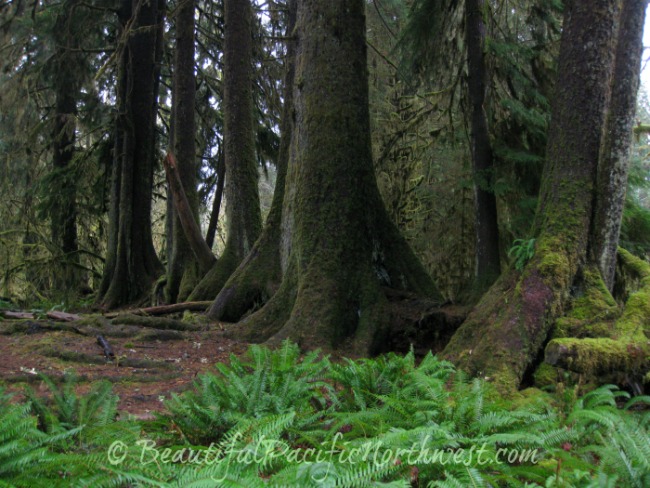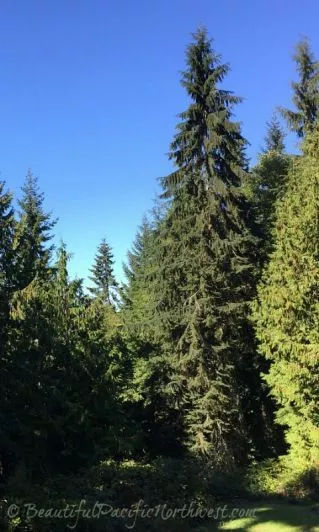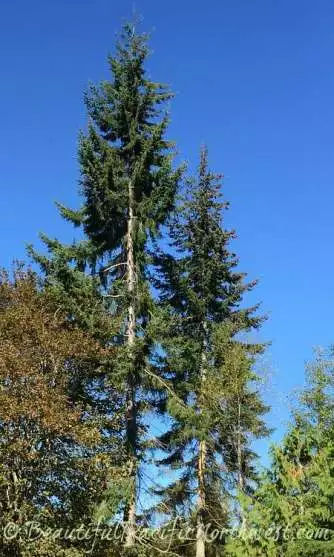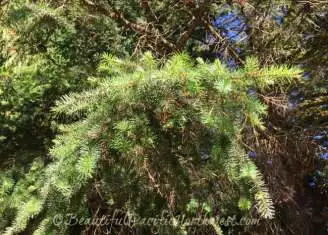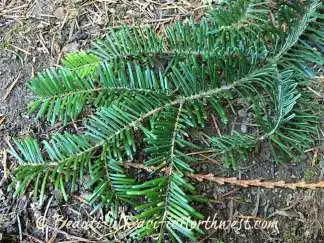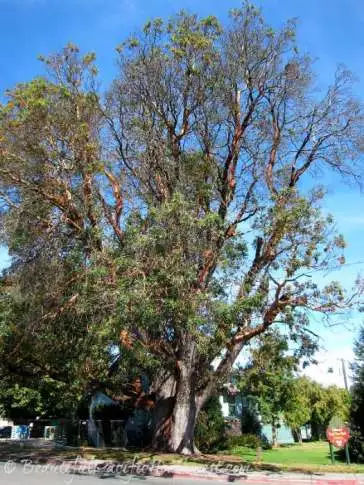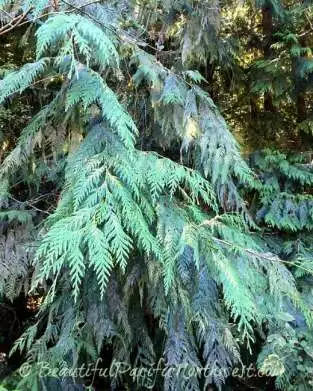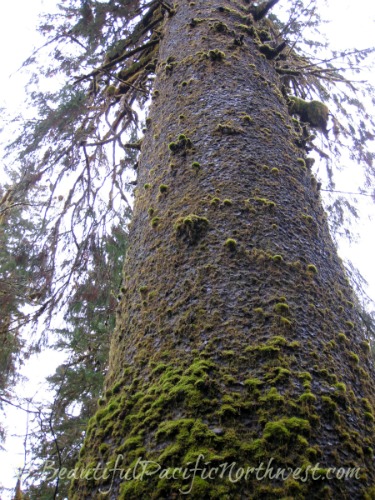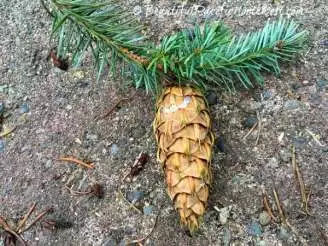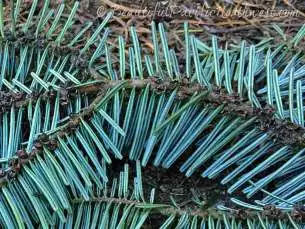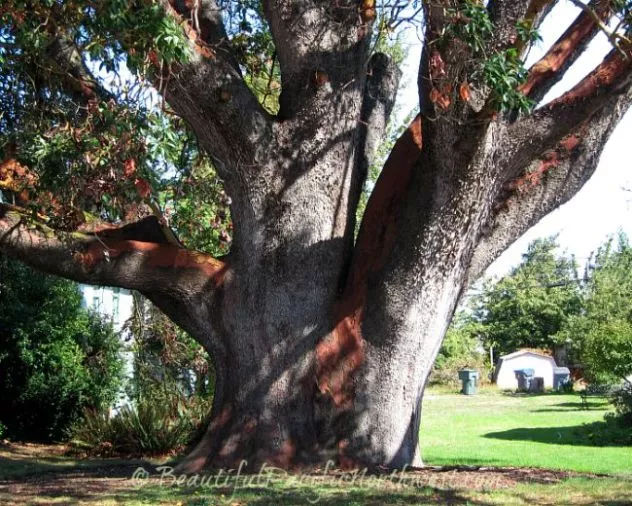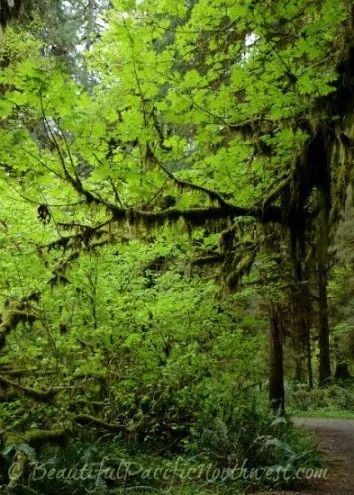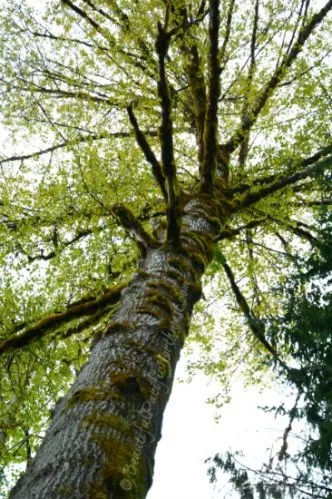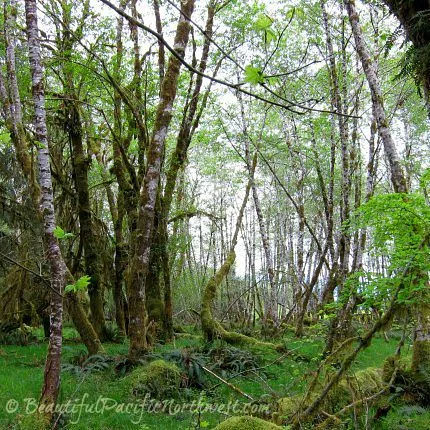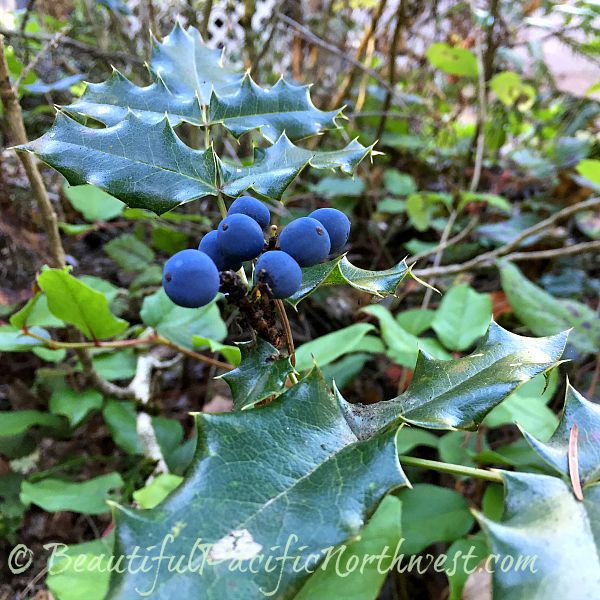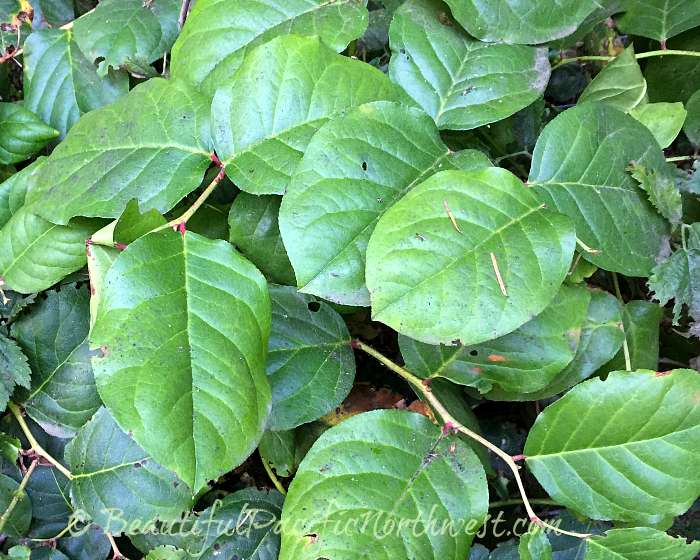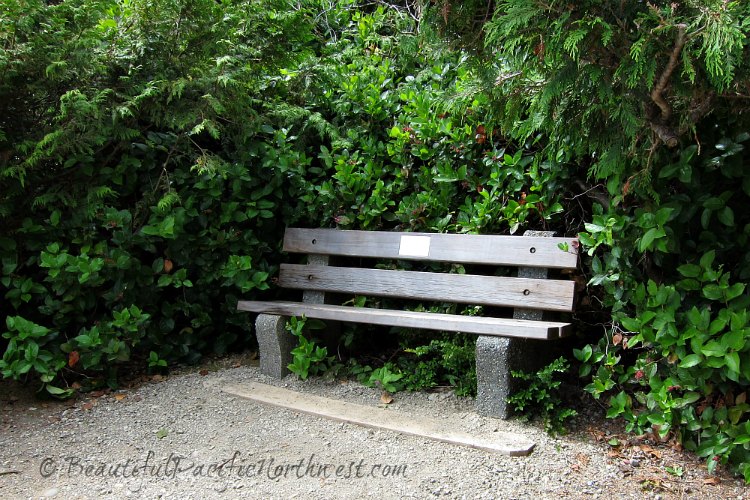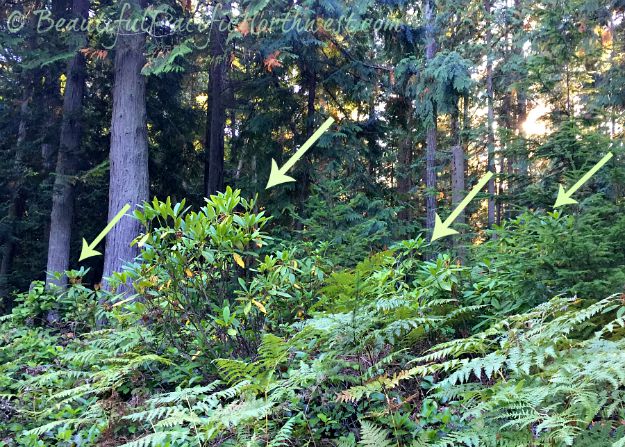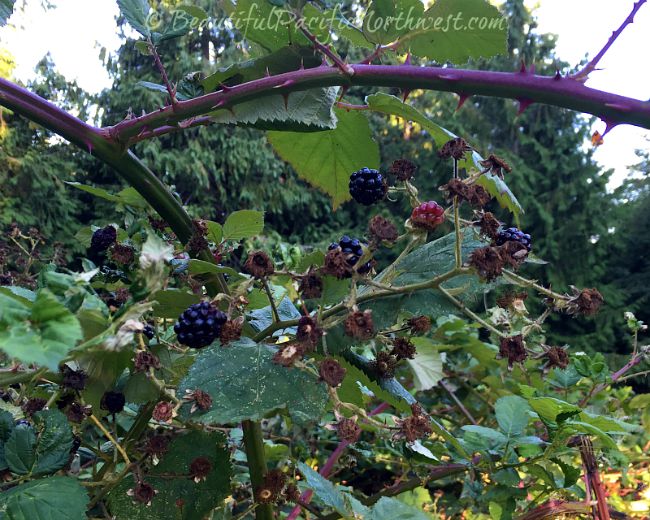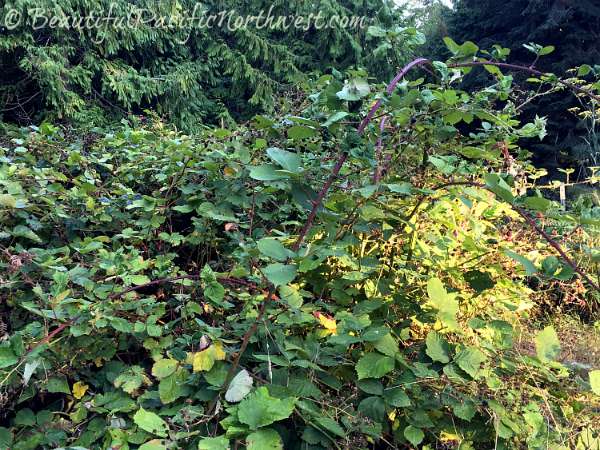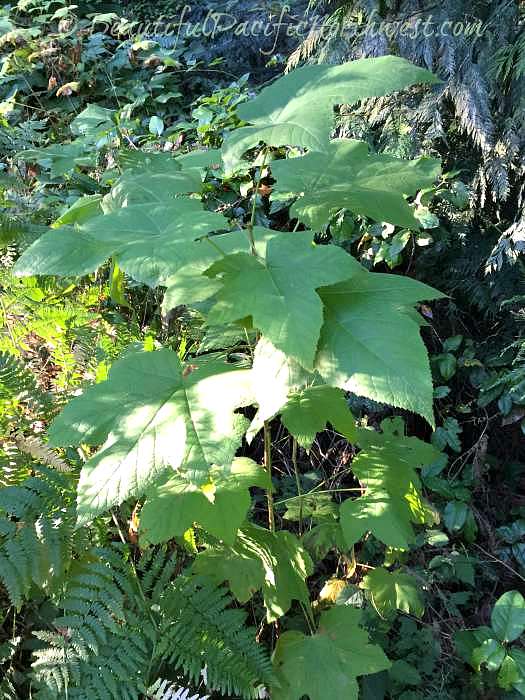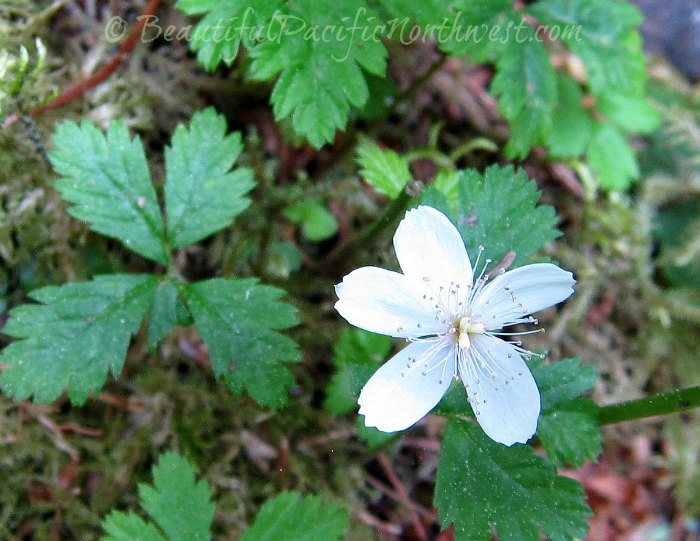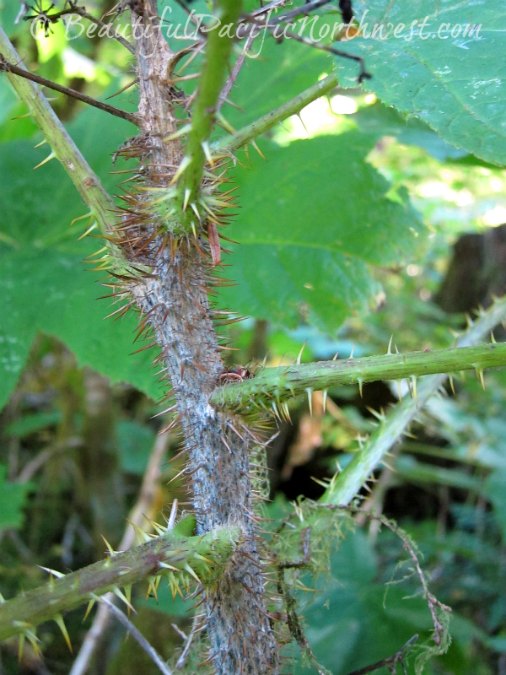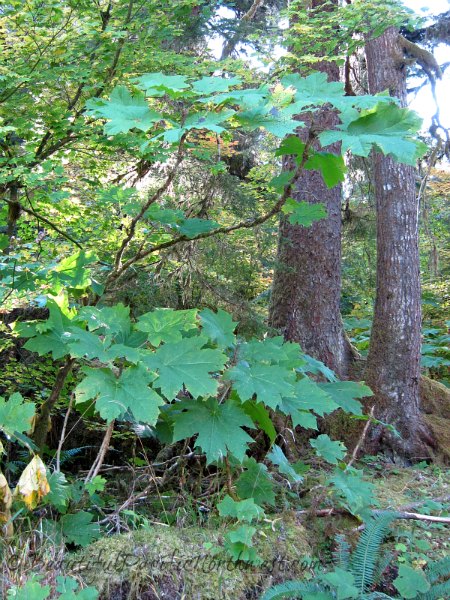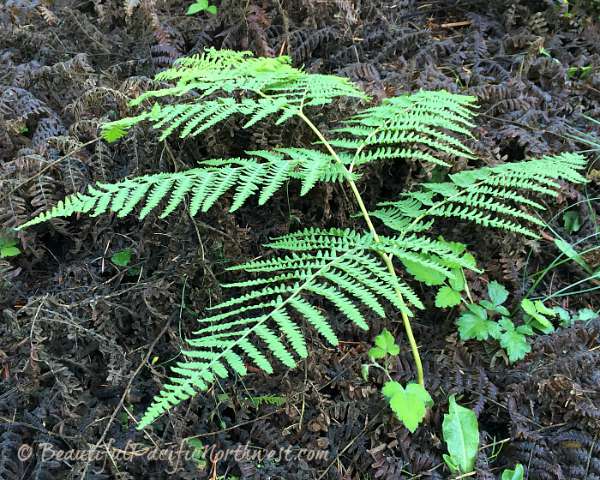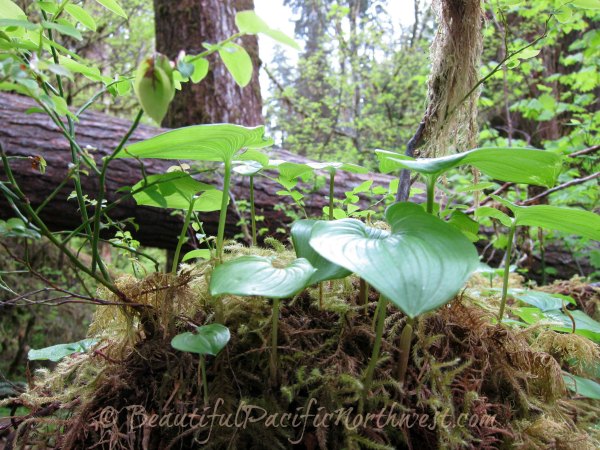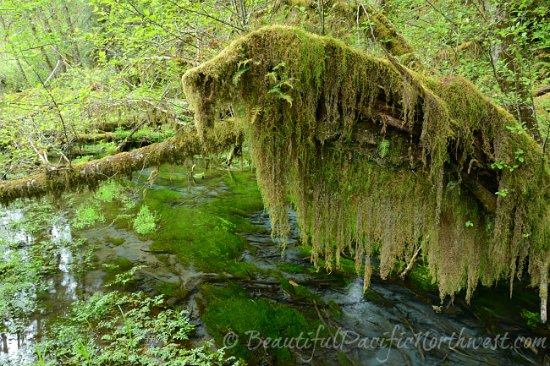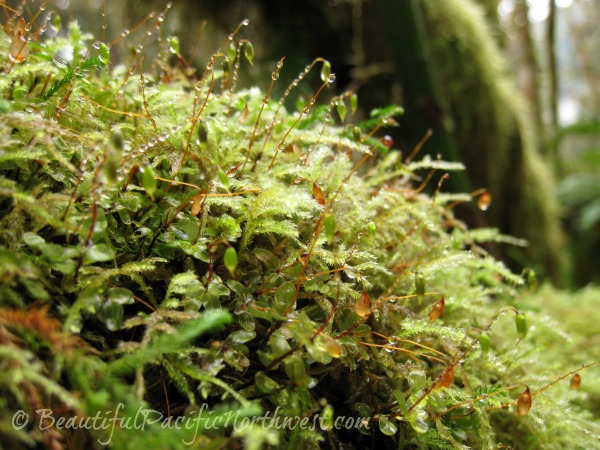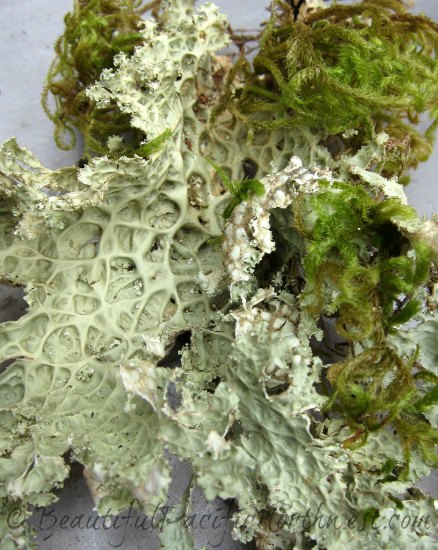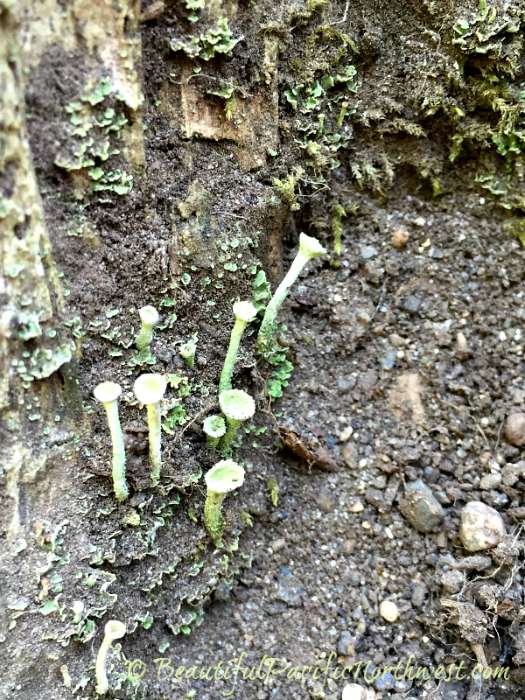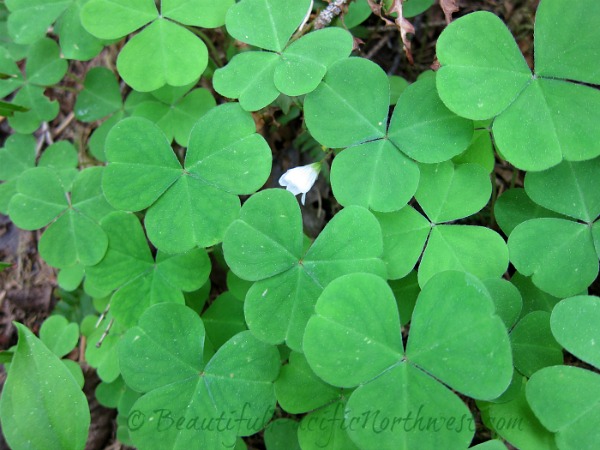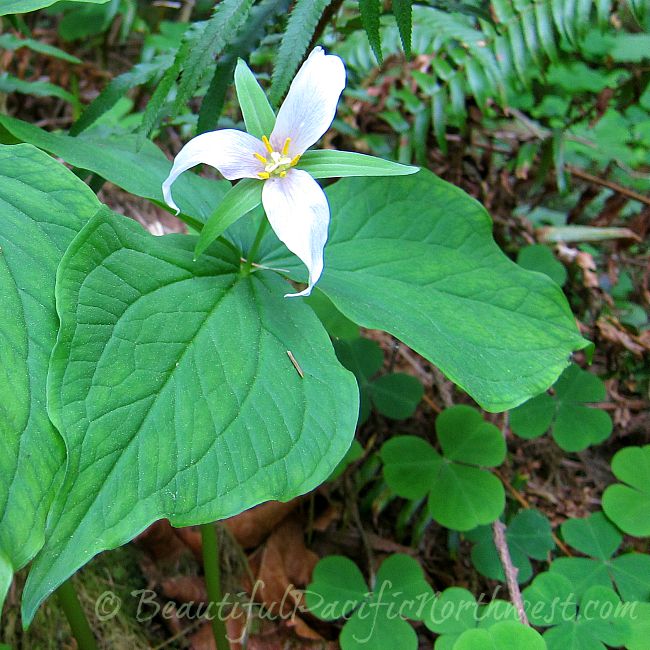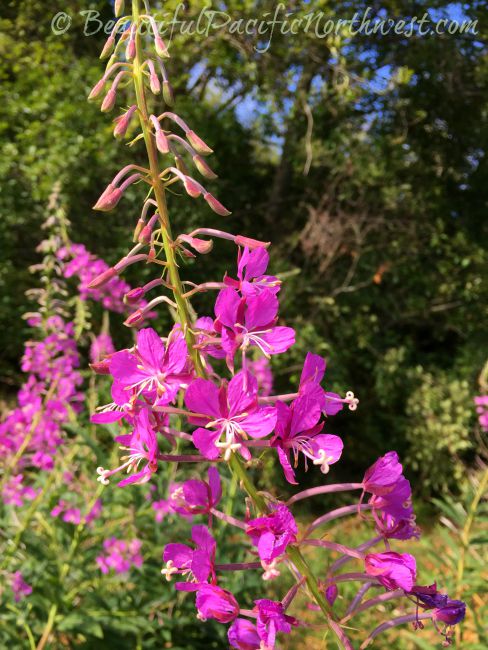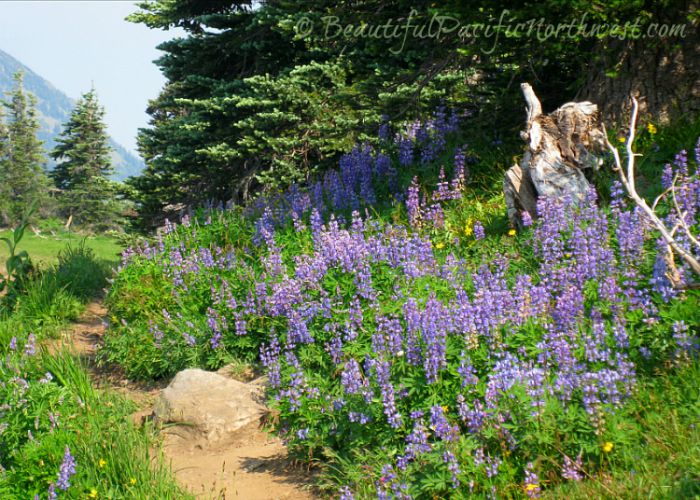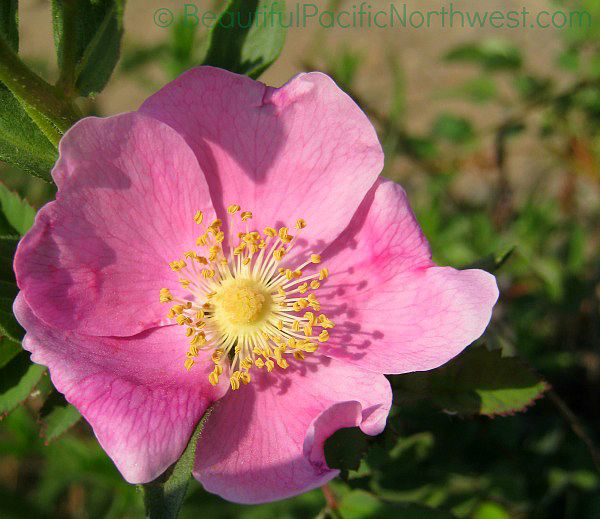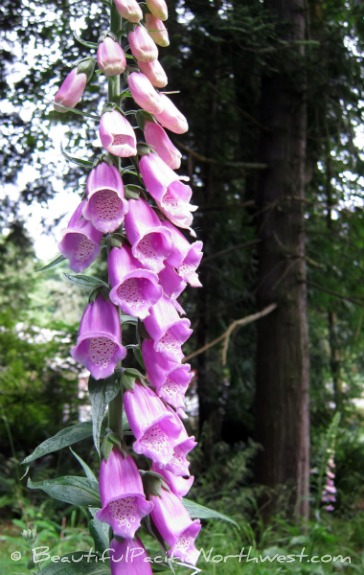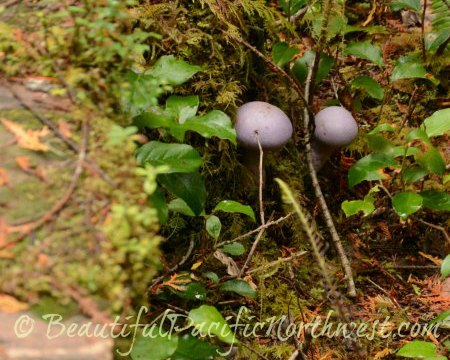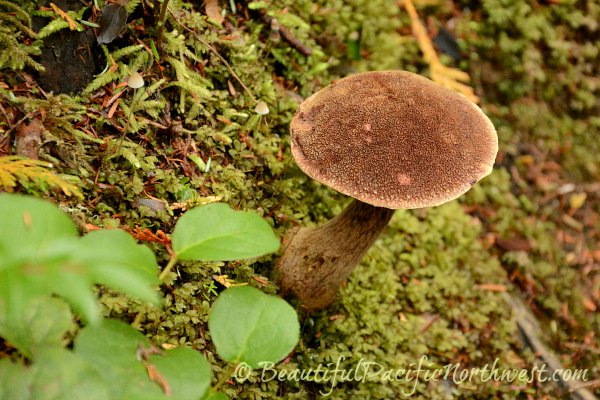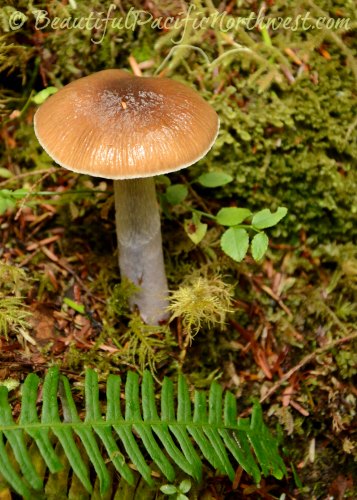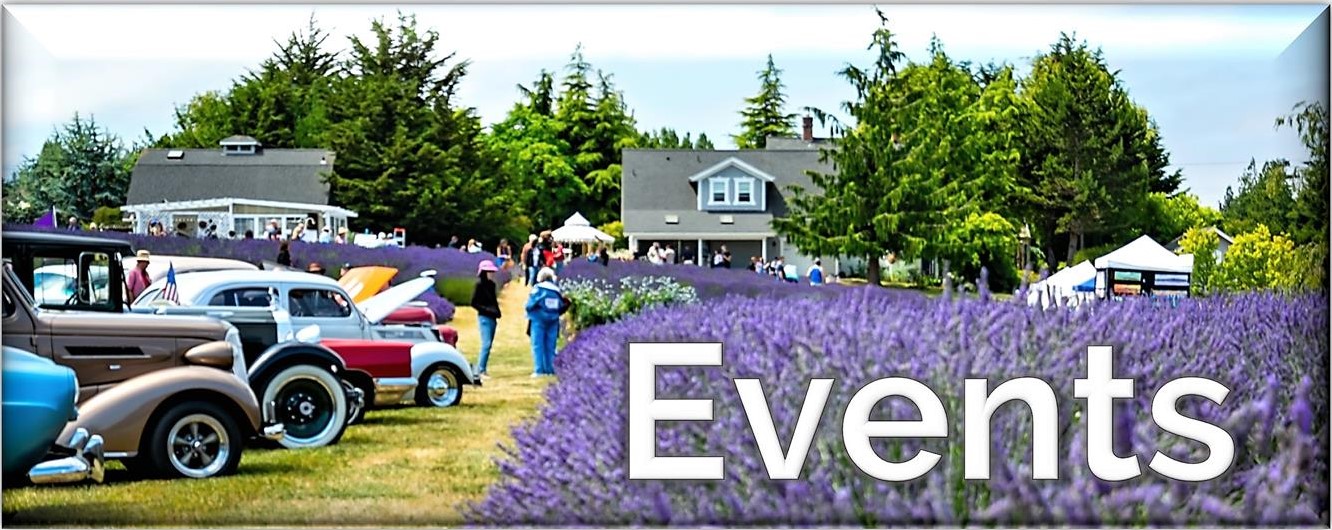Temperate Rainforest
Plants, Trees, Wildflowers, Mushrooms
Temperate rainforest plants: Lists, info, and photos of plants, trees, wildflowers and mushrooms in the Pacific Northwest, plus links to details.
With typical rainfall in the temperate rainforest of up to 170 inches per year (that would be over 14 feet or 4.47 meters/year), you can be sure the excessive moisture creates a very special environment for some very special flora and fungi.
The temperate rain forest supports hundreds, even thousands of species of rushes, mushrooms, lichens, fungi, mosses and ferns. On this page listing temperate rainforest plants, we cannot possibly list all of these. Nor will we list every single plant that can be found in a temperate rain forest.
But we'll make mention of the main plant species that populate the rain forests in the Olympic National Park.
Click here for Olympic National Park Rainforest animals.
For more complete info on other Pacific Northwest native plants, consider purchasing one or more of the expert resources below.
Temperate Rainforest Plants:
Evergreen Trees
Coniferous trees are so named for the cones and needles they bear, as opposed to broad-leafed types of trees. Because of the great amount of rainfall dumped upon the temperate rainforests of the Pacific Northwest, some coniferous species reach astonishing heights and breadth. It might take up to 12 full-grown men to surround one of these giants hand-to-hand.
Below are listed some of the most common trees in our Pacific Northwest rain forests.
Western Red Cedar (Thuja plicata): This versatile tree is nicknamed the "tree of life." It is used for food, instruments, boats, clothing, and more. Western red Cedar trees are found throughout the Pacific Northwest; several notable specimens may even be mentioned on your hiking guide. And if so mentioned, do go and find them. The experience will inspire awe, and your photos will record the treasured, and sometimes life-changing memories. Western red cedars are some of the largest and longest living trees in the Pacific Northwest.
Sitka Spruce (Picea sitchensis): Sitka Spruce can eventually reach heights of up to 300 feet (91.44 m) tall and 58 feet (17.7 m) around. Sitka spruce wood is very strong for its weight. It is a versatile tree that can be used for food, acoustic instruments and in the airplane and boat industries.
Grand Fir (Abies grandis). Grand and stately, this fast growing conifer is a Pacific Northwest icon. The needles are longer and more sturdy than either Doug Fir or Hemlock, and are a dark and rich forest green. The undersides show a tell-tale white stripe. Grand Fir softwood is used mostly in the paper making industry, but it also has some medicinal uses.
Western Hemlock (Tsuga heterophylla): Named the official tree of Washington State, it can reach up to 230 feet (70 m) tall and 9 feet (2.74 m) in diameter. It is the largest of the hemlock species and not to be confused with poisonous hemlock. It is useful in home construction for its strength and beauty; also for making dyes and personal care items.
Traits of the western hemlock:
- The leading shoot at the top of the tree droops
- The needles are quite short and arrayed from the sides of the branch.
- The branches and needles hang like curtains from the main branches.
- The cones are no bigger than the tip of your thumb.
Douglas Fir (Pseudotsuga menziesii). Pictured in photo at left, from left to right: Big leaf maple in fall, two towering Doug Firs, young red alder; finally at right: a bright green western red cedar tree.
Douglas Fir is the second tallest conifer in the world, reaching up to 242 feet (73.8 m) high and 43 feet (13.1 m) around. It produces excellent timber and is the most common wood used in the construction industry. Douglas Fir is also a favorite species for Christmas trees, although in this case, they are planted in straight rows, cultivated, shaped, and then cut down at the end of November (or later).
Arbutus (Arbutus menziesii), also known as Madrona or Madrone (left and below).
The Madrona is a very impressive evergreen broadleaf tree. Its very smooth new bark is bright chartreuse in color, contrasting richly with peeling shreds of older rufus-colored bark. It can tower to 90 feet (27.4 m), however is usually much shorter. It blossoms in clustered small white flowers which ripen to small red berries. The fruit is not dangerous, but not usually eaten by people (though the birds readily help themselves).
Interestingly, the Saanich peoples (and other tribes) have oral stories of a great flood in the distant past. Because the Madrona tree helped to rescue the people from the waters, they honor it to this day by refusing to use it as firewood.
Temperate Rainforest Plants:
Deciduous Trees
Big Leaf Maple (Acer macrophyllum). The big leaf maple is known both for its large leaves, and its large size, at least for a deciduous tree. Its maple wood is excellent for use as furniture of all sorts, as well as musical instruments.
Vine Maple (Acer circinatum). The multi-trunked rather shrubby vine maple reaches only to 21 feet (6.4 m) or so. The maple-shaped leaves sport up to 9 lobes, instead of the more common 3-5 lobes. In the fall the vine maple grabs your attention with brilliant red and orange leaves.
Red Alder (Alnus rubra). Red Alders are so-named because the inner bark is bright red, and useful for making dyes. The wood, however, is honey-golden, and coveted for fine furniture.
Alders love moisture and sun. They are fast-growing and short-lived. At age 50, they are already old. Alders are the first tree species to colonize a ecologic disruption in the rain forest. As they die out, the other trees - Sitka Spruce, Doug Fir, big-leaf maples, etc., have already rooted, and quickly fill the holes in the canopy.
Alder bark is rich with immune-boosting substances and valued for its medicinal qualities. But additionally, alder wood is considered ideal for fish-smoking, such as moist and tender alder smoked salmon.
Temperate Rainforest Plants:
Bushes and Brambles
Pacific Northwest native plants include quite a few native bushes and brambles. These plants can be found throughout the Pacific Northwest temperate rainforests, filling in beneath conifers and broadleaved trees, and adding texture and color to the beautiful forest tapestry.
Oregon Grape (Mahonia aquifolium). This bushy shrub with prickly holly-shaped leaves can reach 6' tall, producing clusters of yellow flowers followed by tart-tasting purple "grape" like berries. Birds love the berries and people make wine from them.
Salal (Gaultheria shallon). Salal is an evergreen shrub. This temperate rainforest plant grows profusely throughout the understory of the Pacific Northwest rain forests. It has glossy rounded leaves on branches that can reach as high as 10' in ideal growing conditions.
In Spring, salal blooms, during which small whitish or pinkish edible flowers hang like bells from new-growth reddish stalks. The mature fruit are black and round like large huckleberries, and are also edible.
Pacific Rhododendron (Rhododendron macrophylla). If ever there was an iconic native Pacific Northwest temperate rainforest plant, it is the rhododendron. With hundreds of wild varieties, diverse characteristics in barks, flower colors spanning the rainbow, rhododendrons are particularly spectacular in the Olympic Peninsula temperate rain forest. Unsurprisingly, rhodies are the state flower of Washington State.
Pictured at right: Photo was taken in late summer. These wild rhodies bloom pink in April and May.
Rambling Brambles:
Everywhere you look in the Pacific Northwest, you're likely to find a bramble of some sort rambling around the temperate rainforest. Some are hybrids cultivated in home gardens, others are wild plants, but all are delicious.
Blackberry (Rubus urcinus). The blackberry bush sends out a long branch that as it extends, sinks in an arc to the ground. Where the branch touches the earth, it re-roots itself, beginning the process again. In this fashion, blackberry plants eventually form dense and nearly impenetrable brambles accessible with difficulty by bears. Deer and elk also thrive on blackberries.
The human love/hate relationship with this invasive bramble is famous. The vines are all but impossible to control, but we love the blackberries fresh, frozen or fermented!
Come late summer, you'll find Pacific Northwesterners armed with buckets and bowls out en force on city streets, in parks and fields, or along forest trails. Wherever blackberries can be found, the brambles are soon picked clean for pies, cakes, ice cream, syrup, and blackberry wine.
Salmonberries (Rubus spectabilis). Salmonberries are a typical temperate rainforest plant. They look a lot like raspberries but are yellow to orange to red in color, and fragile to handle. Native tribal peoples eat the sprouts and berries with salmon, hence the name. The Rufous hummingbird loves to visit the the deeply colored magenta flowers for the nectar.
Thimbleberries (Rubus parviflorus). Thimbleberries are capable of forming dense brambles due to heavy networking of rhizomes. They have maple-shaped leaves and their blooms are white.
Thimbleberries are red, shallow and raspberry-shaped, with bland to sweet flavor. All the Pacific Northwest peoples ate them, whether fresh or dried into cakes with other berries such as blackberry and salal.
Five-Leaved Bramble (Rubus pedatus, also known as Creeping Raspberry). Creeping raspberry is another typical temperate rainforest plant. Usually found in old-growth forest, the edible berries of the five-leaved bramble mature from the center of the blooms into 1-4 small, soft red berries. Natives did not typically gather them in quantity, but when encountered, picked and blended them with other berry concoctions.
Devil's Club (Oplopanax horridus)
"Horridus" indeed, at least as concerning the multitude of nasty 1 cm spines lining the stems of this widespread bush. Devil's Club leaves are large and maple-leaf shaped. It blooms in bunches of tiny white flowers which produce small, glossy red flattened berries in a pyramidal cluster. The berries are not edible, though bears eat them.
On the other hand, this bush, which grows to 10 feet (3.05 m) in height, figures heavily in the lives and culture of local Indian tribes, at least in the past. The spines could be used to create a blue tattoo ink. The stems (with spines removed) were steeped and the tea used for a wide range of ailments. The joints of branches are strong enough to use as fishing hooks.
Just don't try to force your way through heavy thickets of Devil's Club without ridiculously heavy protection.
Temperate Rainforest Plants:
Ferns
In the temperate rainforest of the Pacific Northwest, carpets of green drape and decorate every surface possible, while ferns grow profusely if and where the trees and brambles give them space. Thousands of species of ferns and epiphytes grow in the Pacific Northwest, and especially in the rain forests. With so many species, the combinations in any one locality are seemingly endless.
Various types and species of ferns add their abundant texture to the forest floor. This site cannot catalog them all, but we'll certainly give you a taste of the rainforest ambiance via photos. For more info, consider purchasing one or more of the expert resources below.
- Bracken Fern (Pteridium aquilinum)
- Sword Fern (Polystichum munitum)
- Deer Fern (Blechnum spicant)
- Maidenhair fern(Adiantum pedatum)
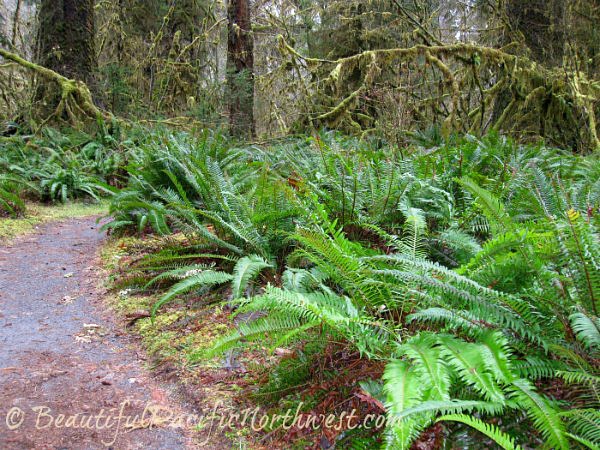 Meadow of sword ferns in the Hoh Rain Forest
Meadow of sword ferns in the Hoh Rain ForestTemperate Rainforest Plants:
Epiphytes
Plants that grow on other plants, such as lichens, mosses and some ferns, are known as epiphytes. Epiphytes can grow very dense. The weight of a dense growth of epiphytes has pulled down large tree branches.
Licorice fern (Polypodium glycyrrhiza), lung-wort (Lobaria pulmonaria), lettuce-lung (Lobaria oregana, also called lettuce lichen), cat-tail moss (Isothecium myosuroides) and Oregon selaginella (Selaginella oregana) are just a few of the many types of epiphytic temperate rainforest plants that grow in the Pacific Northwest.
Temperate Rainforest Plants:
Groundcover
Oregon Oxalis (Oxalis oregana - our type of shamrock), also known as Redwood Sorrel, grows in the deeper shade of the temperate rainforest canopy. Small, white to pink flowers emerge over shamrock shaped leaves which fold down into little pyramids when hit by sunlight.
You are likely to find Oregon Oxalis wherever you choose to visit within the Olympic National Park temperate rain forest.
Temperate Rainforest Plants:
Wildflowers
From the ground huggers that thrive in the rocky soil of the windswept alpine meadows at the top of the Olympic Mountains; to the dainty and the sturdy in the lower elevations, you'll find colors from purple, yellow, pink, white, lavender and orange are scattered everywhere in shade and sun. Here are just a few of our Pacific Northwest native wildflowers:
Columbine (Aquilegia formosa). With flowers like varicolored birds flying above slender stems, these wildflowers are loved by hummingbirds.
Nootka Rose (Rosa nutkana): The Nootka rose, also called the wild rose, is a bushy shrub forming thickets in sunny areas. Its fragrant flowers atop prickly stems attract birds, deer and humans for its use as food, medicine and crafts.
Fireweed (Chamerion angustifolium): Fireweed grows in abundance in meadows, along roadsides and streams from the coast to subalpine forest edges. Its tall, spiky stems topped with showy, hot magenta flowers are very hard to miss!
Trillium (Trillium ovatum): Western Trillium, also known as Wake Robin, is found under the shady canopy of coniferous forests. Trillium plants produce three-petaled flowers atop a whorl of three leaves; blooming white, the flowers deepen to purple as they age.
Foxglove (Digitalis purpurea): Common foxglove is another showy flower that is hard to miss. Purple, pink, or white bell-shaped blooms hang from a central spike.
Beware - this plant is deadly poisonous due to heart-rhythm-altering glycosides in the plant.
Big Leafed Lupine, (Lupinus polyphyllus). These large, showy plants form tall spires of blueish-purple flowers over dense foliage. Tap roots can reach more than 3' long. Ripe seeds explode to scatter everywhere, making this a beautiful but, with some varieties, a potentially invasive wildflower. On the other hand, bumblebees, hummingbirds and butterflies love lupines.
Temperate Rainforest Plants:
Mushrooms
How can we say Olympic National Park temperate rainforest plant without mentioning mushrooms? They are found on the trunks of conifers, under layers of fallen leaves, on the roots of plants, even on animal feces. Walking down a rainforest trail, you won't go far before finding multiple species of mushrooms.
A forest filled with abundant plants and moisture also experiences abundant decay. Fungi, including mushrooms, exist to help break down decaying matter which provides nutrients for insects, which, in turn, feed the species higher on the food chain, for example, birds.
And while some mushroom species are deadly poisonous, others are both edible and delicious, such as these, among many others:
- Golden Chanterelle
- Lobster Mushroom
- Scaly Hedgehog
- The expensive Oregon Black Truffle
Many edible mushrooms have poisonous look-a-likes, so take extreme care. If you aren't 100% certain of the species of mushrooms you have picked for eating, please do some additional research and/or ask questions until you are certain. Here are two websites to help with that:
Mushroaming.com/Pacific_Northwest
Mushroaming.com/Fungal_links - This page catalogs groups and organizations that can help you find and identify mushrooms, not only in the Pacific Northwest.
www.mushroomobserver.org - This website has literally thousands of photos of every conceivable type of mushroom.
www.mushroaming.com offers this serious disclaimer:
"Please do not solely rely on my descriptions and my photos for identification. In case you are not familiar with a mushroom, ask somebody who has survived his or her fungal forays and is familiar with the species you are intending to consume." Why? Because...
"A virtual mis-identification can have real consequences..." when foraging for wild mushrooms, says Debbie Viess, of the Bay Area Mycological Society, "Assume nothing, and learn for several seasons before you eat any wild mushrooms. Use good, regional books, find a mentor, and have your initial IDs checked by more knowledgeable and trusted identifiers."1
In addition to consulting a mushroom expert before indulging your fungal curiosity, you might also acquire one or more books on mushroom identification.
What Are Your Favorite Species of Wild Plant Life in This Area?
Tell Us Your Story and Share Your Photos!
Tell Us Your Story and Share Your Photos!
There is an incredible diversity and amazing array of beauty found in the Pacific Northwest flora! In this region, wild plant life can present as ancient giants, microscopic wonders, intoxicatingly fragrant, some edible, healing, others quite poisonous. Splashes of brilliant in color, or shrouded and mysterious, each one, amazing in its uniqueness...
Do you have a great story about the wild plant life found in the Olympic National Park? We'd love to hear about it and please share your photos as well! Just click into the title box below and go from there. When published, you'll have "your own" page on MyPortAngeles which you can share with friends or anyone who asks!
We're happy to ensure professional and amateur photographers get credit for their work. Leave us your name in the form below, and means of contact, website, or FB page info so we can link back to you.
References:
